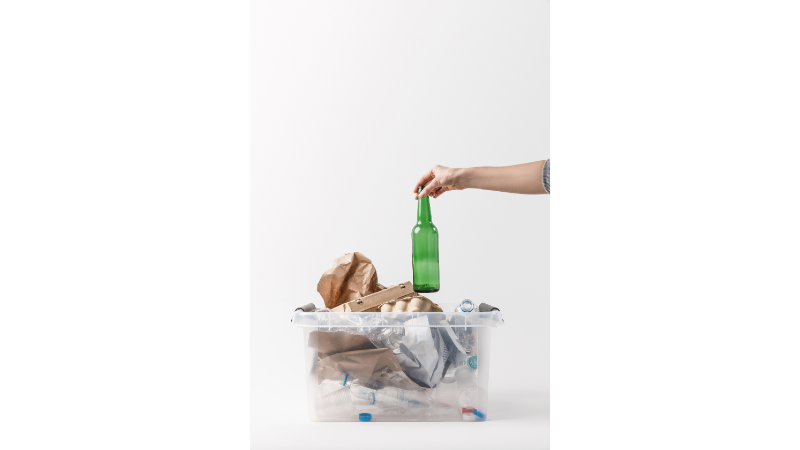The importance of recycling for environmental sustainability is growing every day. However, when asking what is the process for handling non-recyclable waste, it’s important to recognize that not all types of waste can be recycled. The risk of depleting natural resources, climate change, and the increasing volume of waste make this issue more urgent and visible. Some waste becomes unsuitable for recycling due to its chemical composition or level of hazardousness. A high contamination rate can also make certain waste unrecyclable.
In this article, we will explore the environmental impact of non recyclable waste in detail. We will also examine the differences between hazardous and non-hazardous waste, the main criteria used for their classification, and current disposal methods. In addition, we will introduce Burkasan, a company that has been offering integrated waste management systems across Turkey for 25 years. With its extensive experience and commitment to sustainability, Burkasan provides effective solutions tailored to different industries.
Burkasan disposes of non recyclable waste without harming the environment, thanks to its expert team and advanced infrastructure. It also supports businesses in fulfilling their legal obligations regarding waste management. By the end of this article, you will understand how to manage non recyclable waste in a way that aligns with environmental responsibility. You will also gain insight into which methods contribute to long term sustainability.
Table of Contents
- What Are Non-Recyclable Wastes?
- What Is the Difference Between Hazardous and Non-Hazardous Wastes?
- Disposal Methods for Non-Recyclable Wastes
- Regulations on Non-Recyclable Waste Management in Turkey
- Frequently Asked Questions
- Conclusion
What Are Non-Recyclable Wastes?
Not all waste is recyclable. Non-recyclable waste refers to materials that cannot be recovered through current technologies, either economically or environmentally. These types of waste typically consist of materials that are structurally difficult to separate or heavily contaminated to the point of disrupting the recycling process.
The main types of waste classified under this category include:
- Heavily contaminated plastics and packaging materials: Plastics that have come into contact with food waste or have greasy surfaces cause serious issues in recycling processes. These materials are often deemed non-recyclable.
- Laminated paper products: Multi-layered packaging, such as milk cartons, contain various materials that cannot be separated. This makes their recycling impossible.
- Ceramics, fiberglass, and certain construction and demolition wastes: These materials are difficult to process and are often highly contaminated after use. Therefore, they are not suitable for recycling.
- Mixed household waste: Paper, cardboard, and plastic items that have been in contact with food leftovers are excluded from the recycling chain due to contamination risks.
- Medical and hazardous waste: These include infected, chemically treated, or biologically risky materials. Such waste must be disposed of through specialized processes to prevent harm to public health.
It is critically important to collect these types of waste separately from others. If non-recyclable waste is not properly managed, it can lead to severe environmental problems. These wastes contribute to pollution and can degrade groundwater and soil quality. They also pose significant risks to public health. For this reason, the management of non-recyclable waste requires professional systems and processes that comply with legal regulations.

What Is the Difference Between Hazardous and Non-Hazardous Wastes?
One of the most critical distinctions in waste management is the classification of waste as either “hazardous” or “non-hazardous.” This distinction is also a key part of answering the question: what is the process for handling non-recyclable waste? This classification not only defines the nature of the waste. It also determines how the waste must be collected, transported, stored, and ultimately disposed of.
Hazardous waste refers to materials that can cause serious and long-term harm to both human health and the environment. These wastes often contain heavy metals, toxic chemicals, or flammable and explosive substances. If released into the environment without proper control, hazardous waste can contaminate groundwater, soil, and air. Over time, it may enter the food chain. It can pose risks to all forms of life.
Non-hazardous waste, as the name suggests, does not present an immediate danger to human health. However, if not managed correctly, it can still have significant environmental consequences. This category typically includes household waste such as food scraps, paper, plastic, glass, and metal packaging. Although these materials are less dangerous, careless disposal can still lead to pollution. It can also result in the waste of valuable resources.
In conclusion, understanding the difference between hazardous and non-hazardous waste is fundamental.
It plays a key role in determining what is the process for handling non-recyclable waste. Each type of waste requires its own collection, transportation, and disposal systems. Hazardous waste must be clearly labeled and handled with strict safety protocols and monitoring. Non-hazardous waste, on the other hand, can be reintegrated into the economy through efficient recycling systems. Recognizing and applying these distinctions not only fulfills legal responsibilities. It also supports environmental protection and public health.
Disposal Methods for Non-Recyclable Wastes
The disposal of non-recyclable waste is crucial for minimizing environmental impacts and protecting human health. The method applied must be determined based on the physical and chemical properties of the waste. Legal compliance, environmental sustainability, and cost factors should also be considered. The most commonly used disposal methods include:
- Landfilling (Sanitary Landfill)
Landfilling is one of the most frequently used methods for disposing of non-recyclable waste. Leachate generated by the buried waste is collected and treated to prevent environmental damage. Additionally, methane gas formed during the process is captured using special systems. It is either safely neutralized or used for energy production. This method is preferred for safely isolating non-hazardous but non-recyclable waste. However, it requires significant space and may lead to land scarcity in the long term. - Incineration (Thermal Combustion)
Incineration provides an effective and rapid solution for disposing of high-volume non-recyclable waste. This method involves burning waste at high temperatures to reduce its volume. It is especially suitable for medical waste with pathogenic risks and hazardous chemicals. Some modern incineration facilities also recover energy during the process. However, to apply this method, emission control units with advanced filtration systems are required. - Chemical Stabilization
The chemical stabilization method aims to eliminate the environmental hazards of waste by altering its chemical structure. This approach is commonly used for hazardous waste containing heavy metals. The waste is mixed with binding agents such as cement or lime to solidify it. As a result, its reactive properties are neutralized.

Regulations on Non-Recyclable Waste Management in Turkey
In Turkey, the management of non-recyclable waste is regulated by detailed legislation.
This aims to ensure environmental sustainability and protect public health. These legal regulations are enforced by the Ministry of Environment, Urbanization, and Climate Change. To dispose of non-recyclable waste without harming the environment, both waste producers and disposal facilities have responsibilities. Each plays a key role in ensuring proper and safe waste management. They must act responsibly to ensure proper waste management. They are legally required to comply with these regulations.
The main legal frameworks applied within this scope include:
- Waste Management Regulation:
This regulation defines general rules for the segregation, collection, and transportation of waste. It also outlines procedures for the proper disposal of waste at its source. - Regulation on the Control of Hazardous Waste:
Hazardous waste poses significant risks to human health and the environment. Therefore, detailed provisions apply to the classification, labeling, and disposal of these wastes. Non-recyclable waste that contains chemical or biological risks falls under this regulation. - Technical Standards for Disposal Facilities:
These standards define the infrastructure, technological, and operational requirements for disposal facilities. Facilities must meet these requirements to safely process waste. Leachate control, emission management, and monitoring systems are mandatory within this framework. - Waste Declaration System and Monitoring Obligations:
All waste-producing businesses are subject to specific obligations. These businesses must submit annual waste declarations and ensure proper tracking of their waste. This system increases transparency.
In accordance with these regulations, businesses are required to work only with licensed disposal companies. These companies must also be officially authorized to handle non-recyclable waste.
Waste must also be collected separately according to its type. Regular reporting and online declaration through digital systems are also legal obligations.

Frequently Asked Questions
Why should non-recyclable waste be collected separately?
Because this type of waste cannot be directly included in the recycling system. When mixed with other recyclable materials, they may contaminate the entire batch. This leads to environmental harm and significantly reduces recycling efficiency.
How can I separate non-recyclable waste at home?
When sorting waste at home, recyclable materials such as plastic, metal, glass, and paper should be placed in separate bags. Food scraps, contaminated packaging, hygiene products, and similar items should be disposed of properly. They must be placed in the general waste bin. They are not suitable for recycling and must be kept separate from recyclable materials. This ensures proper separation from recyclable materials.
How is hazardous waste defined?
Hazardous waste includes substances that pose a risk to human health and the environment. These wastes may be flammable, explosive, corrosive, or infectious. Examples include leftover paint, batteries, medical waste, and certain cleaning products.
How do disposal facilities work?
The final treatment of non-recyclable waste is carried out in licensed disposal facilities. Different methods are applied depending on the type of waste. These include incineration (thermal treatment), sanitary landfilling, and chemical stabilization.
Which household items can be considered hazardous waste?
Used batteries, fluorescent bulbs, leftover medications, paint cans, and some cleaning products may appear domestic. However, they fall under the category of hazardous waste. These items should not be placed in recycling bins. Instead, they should be delivered to designated municipal collection points.
Why should businesses work with professional waste management companies?
Because the proper disposal of non-recyclable waste is a legal obligation. Professional companies minimize environmental risks, optimize costs, and manage reporting processes digitally.
Conclusion
Proper disposal of non-recyclable waste is of critical importance for protecting environmental health.
It also ensures the sustainable use of natural resources and helps leave a livable world for future generations. In this article, we provided a detailed and scientifically grounded answer.
This process begins with waste classification and extends to disposal methods and legal obligations. It can only be effectively managed through both individual awareness and professional institutional solutions. In Turkey, the successful implementation of this system requires more than just regulations. It also depends on the collaboration of producers, consumers, and waste managers.
At this point, the importance of expert companies such as Burkasan becomes even more evident. With over 25 years of experience, Burkasan offers integrated disposal solutions. These solutions minimize the environmental impact of non-recyclable waste. It not only ensures that businesses comply with regulations. It also helps them develop environmentally responsible and sustainable waste management strategies.
In conclusion, the management of non-recyclable waste is not merely a legal obligation. It is also an investment in the future. If you want to meet your legal responsibilities and foster an eco-friendly business culture. You can confidently manage this process with the support of professional waste management services.
Following this comprehensive article on what is the process for handling non-recyclable waste, feel free to explore our other blog posts. They offer additional insights into waste management, recycling practices, and environmental sustainability. These additional resources offer valuable insights into recycling, waste management, and sustainability. Expand your knowledge on waste management, recycling, and sustainability.
Don’t forget to visit our blog page for more.

